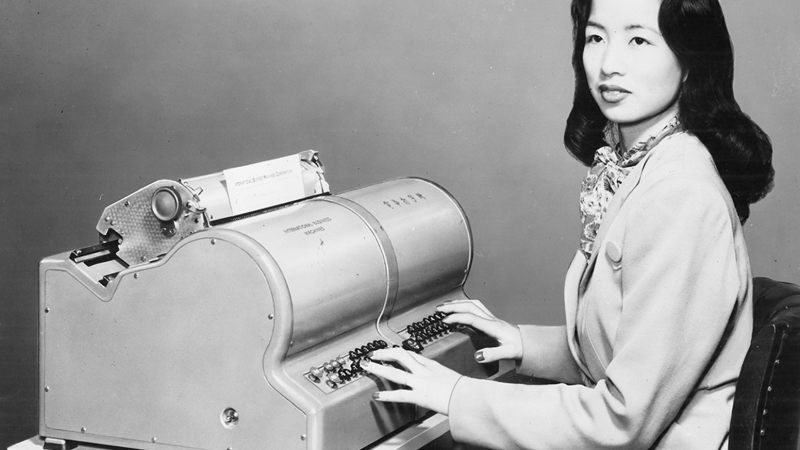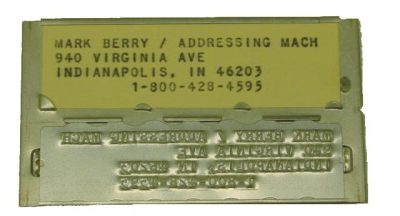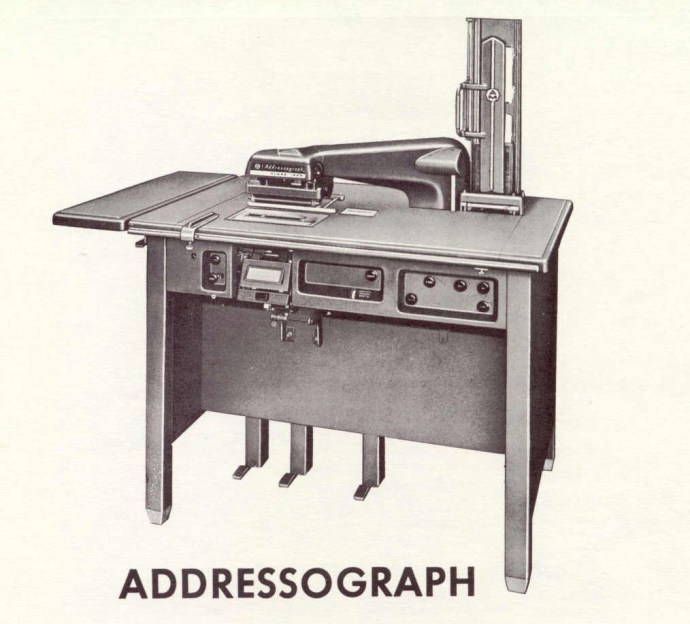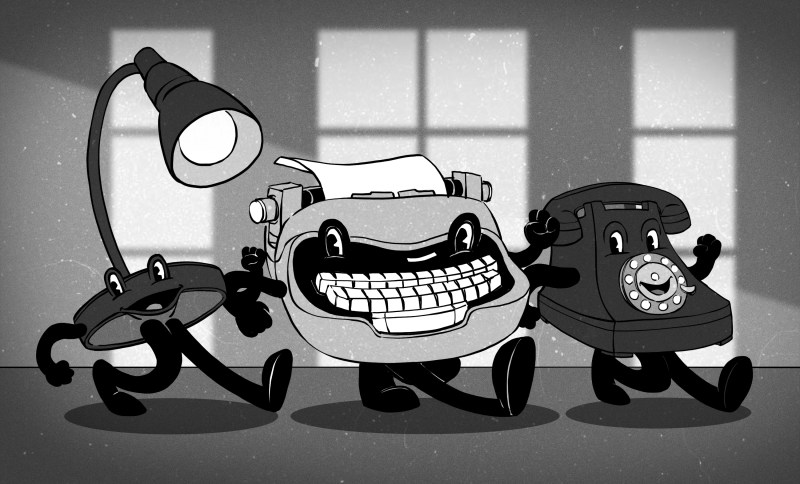If you can’t imagine writing a letter on a typewriter and putting it in a mailbox, then you take computers for granted. But that’s just the tip of the iceberg. More niche applications begat niche machines, and a number of them are on display in this film that the Computer History Archives Project released last month. Aside from the File-o-matic Desk, the Addressograph, or the Sound Scriber, there a number of other devices that give us a peek into a bygone era.

One machine that’s still around, although in a much computerized form, is the stenograph. Not so popular these days is the convenient stenograph carrier, allowing a patient’s statement to be recorded bedside in the hospital immediately after a car accident. Wire recorders were all the rage in 1947, as were floppy disks (for audio, not data). Both media were used to time-shift dictation. Typing champions like Stella Pajunas could transcribe your letters and memos at 140 WPM using an electric typewriter, outpacing dot matrix printers but a snail’s pace compared to a laser jet.
Typing Ten Feet Wide
Before the IBM Selectric and its changeable font balls, there was the Varityper. It was a sophisticated typewriter supporting multiple fonts and proportional spacing. An unusual one is shown here, used for typing notes on engineering drawings and maps up to ten feet wide, in various fonts and sizes.

Chinese Typewriter is Innovative but Flops
Next we have the IBM electronic Chinese typewriter, the invention of IBM Rochester engineer [Kao Chung-Chin] (US patent 2,412,777, Dec 1946). In his design, [Kao]’s solution to handling thousands of Chinese glyphs is not a monster keyboard. Rather, he requires the typist to enter a four-digit code using a modest number of keys. In modern terms, this would be like typing your document using Unicode values on a numeric keypad. Despite this impediment, IBM worker [Lois Lew] managed a respectable 45 WPM on this behemoth. And unlike the typewriter project, which was cancelled, [Lois] is still alive and kicking in Rochester. She recently connected with Stanford University professor [Thomas Mullaney] who is a researcher in Chinese history and focuses on typewriters. You can read his piece on this typewriter’s history and [Lois]’s involvement with the project in this article he wrote back in May.

Feeling Really Old

I recognized, and actually used a few of the items featured in this film. My father’s workplace, where I would sometimes hang out after school, had a few of these machines back in the 1970s. The most spectacular was the Addressograph system, used to prepare mailings for newsletters, post cards, etc. It was basically a mechanical database. Each person was represented by a special card, prepared by a Graphotype machine, a specialized typewriter that embosses text on small metal plates, not unlike a dog-tag. The card was actually a frame, which held the embossed plate, a piece of card stock with the information typed by conventional means, and a series of slots along the top of the card which could hold metal tabs. These tabs denoted different user-defined categories. In an engineering company, for example, you could designate tab positions for each department, for each building, for each project team, etc. The entire company roster is now contained in one or more filing drawers, each about the size of an old-fashioned library card catalog drawer.

When you want to send out a letter to all the mechanical engineers working in the Poughkeepsie office, the operator would set up the Addressograph machine accordingly. The stack of cards from each drawer is slid into the feed rack, and each card is conveyed one-by-one through the machine for printing. Only those cards whose tabs match the setup are printed onto the envelopes. Cards not selected for the mailing would be passed over. After some time, my Dad realized that each drawer had its own quirks and temperament, so he gave each of them names.
Pedro could always be counted upon to misbehave.
These machines required a bit of maintenance to keep running, but they were built like a tank. The ones I encountered as a teenager were purchased in the late 1940s and kept operational until the early 1980s, when other affordable options became viable. That seems like a long time today, when office equipment has lifespans measured in years not decades. Despite getting the job done, such single-purpose specialized office machines have all but vanished from the typical office these days. And no wonder — almost every function featured in this film can be done today with a desktop computer and a multifunction printer / scanner.
Check out the the video below the break. Are you still using any obsolete office equipment today? Let us know in the comments below.
















Audio floppy disks in 1947? How can I get any rest now that there’s *that* to chase down?
https://obsoletemedia.org/soundscriber/
Sleep well (and dream of large women).
HAVE FUN STORMING THE CASTLE!
Ohhh, yeah, I see now that floppy disk did not mean what I thought it meant. But, it is a disk, and it is floppy, so what else would you call it. Lol, now I want to use one to replace the cassette recorder for a TRS-80, and “save my programs to disk” that way
That sounded familiar.
So physically, kind of like those records included in magazines. Thin and flexible, they were stitched into the binding.
I want to say there were vending machines whete you could record a record, but I think that time at Disneyland, it was a more solid record that came out. It’s been almost sixty years.
Saved you some trouble, assuming you don’t mind a fixer-upper: https://www.ebay.com/itm/203709094112?hash=item2f6e0218e0:g:~V0AAOSw5XdhmpMi https://www.ebay.com/itm/294186898813?hash=item447ee7d57d:g:eXMAAOSwSYZgp8mf .
Though in fairness unlike floppies it’s a mechanical recorder, not magnetic, that embosses the disc with the recording stylus. I’m not sure if there’s a magnetic disc recorder from that time frame. The closest I’ve come into contact with is the Tomy Chatbot which could record and play a short voice message from a fully mechanically driven disc mechanism: http://www.theoldrobots.com/images14/ChatbotInsides2.JPG
Possibly he is referring to the Soundscriber?
https://en.wikipedia.org/wiki/SoundScriber
There appear to be a few videos on YouTube where they are being re-purposed to cut records.
IBM made a few magnetic recorders using a ferrous band for dictation
Now I’m tempted to convert a 3.5″ HD Floppy drive for audio recording. I would need to make a large gear ratio reduction for the head movement to change the format from concentric to spiral. The rest should be easy.
There were many dictating machines using a magnetic platter of some kind. The most famous one (at least in Europe) is the Dimaphon by Assmann (Germany).
http://www.tonbandmuseum.info/das-assmann-dimafon-1.html
Long before ferric platter designs there were machines that recorded straight onto a piece if wire like a real to real but with wire instead. These were mostly German as they engineered the early technology during the war years. The wire idea wasn’t very good as it quickly wore the heads out.
Different manufacturers made up their own standards even when they moved to ferric coated tape. The tape widths were different. The tape speeds were different. Even the position of the recording on the tape was different.
I repaired a 30s / 40’s unit and it had in it what appeared to be a Aluminum / Magnesium allow which had completely decomposed. The early units had state of the art engineering in them so they must have been hugely expensive at the time.
We have a slim desktop magnetic disk recorder if I recall. In the 80’s I remember the tech before me playing around with it and then the only disc vanished. It came from Purdue salvage which included some 4 minute wax cylinder steel cabinet clad devices. A worker at the time remarked they were incompatible with first gen Edison records (3 min).
Much later I looked into it and realized that floor sitting chassis full of tubes got thrown out long ago. If I remember the name was Edison Voicewriter. It had a scroll pointer slider across the slot to find find a part quickly out of some 3 minutes, this was connected to the head like a hard disc. I thought of hacking it into a Laurie Anderson type track sampler.
As a child I remember my mom talking about what was one of was one of her few jobs in life, operating a Dictaphone (spell check knows) and typing out the dictation. They were non electric. Nice to have lived in a time when the word babysitter was an infrequent event. Day-care didn’t exist yet. I saw a lot of early network TV.
That first thing with the big wall chart that has the movable markers could easily be re-created on a large flat panel display, and zoomable to hold even more tracking information.
I couldn’t find any more information about that wall chart. It seemed like the action of moving the pegs could be read by the machine. Is there any output from the machine onto the wall?
Only got about 1 minute in and this narrator is amazing!
“Files come from… somewhere…”
It is like he is making it up as he goes along. It is so funny.
Thanks for this. Love the old machines too of course.